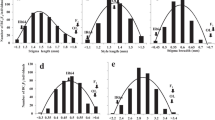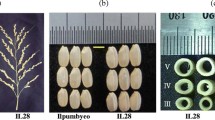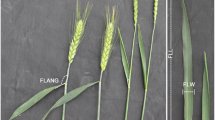Abstract.
To understand the genetic basis of floral traits associated with the mating system in rice, we analyzed pistil, stamen and glume traits using a recombinant inbred line population, derived from a cross between an Asian cultivated rice (Oryza sativa L.), Pei-kuh, and a wild rice (Oryza rufipogon Griff.), W1944. Quantitative trait loci (QTLs) affecting floral morphology were detected by composite interval mapping using a linkage map constructed using 147 markers, mostly RFLPs. A total of 7, 4, 14 and 6 QTLs were detected for traits related to pistil, stamen, and size and shape of the glume, respectively. Comparison of 31 QTLs affecting these organs revealed ten QTLs affecting the different organs in four adjacent regions on chromosomes 2, 4, 5 and 10, but most QTLs (68%) were located separately on the whole chromosomes. Although four QTLs for stigma breadth, anther length and thickness of lemma and palea explained more than 25% of the total phenotypic variance, most QTLs (87%) had smaller effects. These results suggest that quantitative variation observed for pistil, stamen and glume traits is controlled by several distinct genes with small effects.



Similar content being viewed by others
References
Basten CJ, Weir BS, Zeng ZB (1994) Zmap – a QTL cartographer. Computing strategies and softwear. Proc 5th Congr on Genetics Applied to Livestock Production, Guelph, Ontario
Bernacchi D, Tanksley SD (1997) An interspecific backcross of Lycopersicon esculentum × L. hirsutum: linkage analysis and a QTL study of sexual compatibility factors and floral traits. Genetics 147:861–877
Bradshaw Jr HD, Wilbert SM, Otto KG, Schemske DW (1995) Genetic mapping of floral traits associated with reproductive isolation in monkeyflowers (Mimulus). Nature 376:762–765
Bradshaw Jr HD, Otto KG, Frewen BE, McKay JK, Schemske DW (1998) Quantitative trait loci affecting differences in floral morphology between two species of monkeyflower (Mimulus). Genetics 149:367–382
Cai HW, Morishima H (2002) QTL clusters reflect character associations in wild and cultivated rice. Theor Appl Genet 104:1217–1228
Causse MA, Fulton TM, Cho YG, Ahn SN, Chunwongse J, Wu K, Xiao J, Yu Z, Ronald PC, Harrington SE, Second G, McCouch SR, Tanksley SD (1994) Saturated molecular map of the rice genome based on an interspecific backcross population. Genetics 138:1251–1274
Churchill GA, Doerge RW (1994) Empirical threshold values for quantitative trait mapping. Genetics 138:963–971
Furuta N, Ninomiya S, Takahashi N, Ohmori H, Ukai Y (1995) Quantitative evaluation of soybean (Glycine max L. Merr.) leaflet shape by principal component scores based on elliptic Fourier descriptor. Breed Sci 45:315–320
Georgiady MS, Whitkus RW, Lord EM (2002) Genetic analysis of traits distinguishing outcrossing and self-pollinating forms of currant tomato, Lycopersicon pimpinellifolium (Jusl.) Mill. Genetics 161:333–344
Harushima Y, Yano M, Shomura A, Sato M, Shimano T, Kuboki Y, Yamamoto T, Lin SY, Antonio BA, Parco A, Kajiya H, Huang N, Yamamoto K, Nagamura Y, Kurata N, Khush GS, Sasaki T (1998) A high-density rice genetic linkage map with 2,275 markers using a single F2 population. Genetics 148:479–494
Huang N, Parco A, Mew T, Magpantay G, McCouch S, Guiderdoni E, Xu JC, Subudhi P, Angeles ER, Khush GS (1997) RFLP mapping of isozymes, RAPD and QTLs for grain shape, and brown planthopper resistance in a doubled-haploid rice population. Mol Breed 3:105–113
Iwata H (1998) Evaluation and statistical genetic analysis of plant morphology based on elliptic Fourier descriptors (in Japanese). PhD Thesis, University of Tokyo, Japan
Juenger T, Purugganan M, MacKay TFC (2000) Quantitative trait loci floral morphology in Arabidopsis thaliana. Genetics 156:1379–1392
Kato H, Namai H (1987) Intervarietal variations of floral characteristics with special reference to F1 seed production in Japonica rice (Oryza sativa L.) (in Japanese with English summary). Jpn J Breed 37:75–87
Kuhl FP, Giardina CR (1982) Elliptic Fourier features of a closed contour. Comp Graph Image Proc 18:236–258
Lin J-Z, Ritland K (1997) Quantitative trait loci differentiating the outbreeding Mimulus guttatus from the inbreeding M. platycalyx. Genetics 146:1115–1121
Lynch M, Walsh B (1998) Genetics and analysis of quantitative traits. Sinauer associates, Sunderland, Massachusetts, pp 448–450
Manly KF (1993) A Macintosh program for storage and analysis of experimental genetic mapping data. Mammal Genome 4:303–313
McCouch SR, Cho YG, Yano M, Paul E, Blinstrub M, Morishima H, Kinoshita T (1997) Report on QTL nomenclature. Rice Genet Newslett 14:11–13
Nagato Y, Yoshimura A (1998) Report of the committee on gene symbolization, nomenclature and linkage groups. Rice Genet Newslett 15:13–74
Oka H, Morishima H (1967) Variations in the breeding systems of wild rice, Oryza perennis. Evolution 21:249–258
Oka H, Morishima H (1997) Wild and cultivated rice. In: Matuo T, Hoshikawa K (eds) Science of the rice plant. 3. Genetics. Food and Agriculture Policy Research Center, Tokyo, pp 88–111
Parmar KS, Siddiq EA, Swaminathan MS (1979) Variation in components of flowering behavior of rice. Indian J Genet Plant Breed 39:542–550
Rangaswamy M, Kumar CHMV (1995) Growth, development and floral biology of rice in relation to heterosis breeding. In: Hybrid rice seed production technology: theory and practice. Directorate of Rice Research, Rajendranagar, Hyderabad, India, pp 43–49
Redoña ED, Mackill DJ (1998) Quantitative trait locus analysis for rice panicle and grain characters. Theor Appl Genet 96:957–963
Singh K, Ishii T, Parco A, Huang N, Brar DS, Khush GS (1996) Centromere mapping and orientation of the molecular linkage map of rice (Oryza sativa L.). Proc Natl Acad Sci USA 93:6163–6168
Takeoka Y, Shimizu M, Wada T (1993) Panicles. In: Matuo T, Hoshikawa K (eds) Science of the rice plant. 1. Morphology. Food and Agriculture Policy Research Center, Tokyo, pp 295–338
Veldboom LR, Lee M, Wodman WL (1994) Molecular marker-facilitated studies in an elite maize population. I. Linkage analysis and determination of QTLs for morphological traits. Theor Appl Genet 88:7–16
Virmani SS (1994) Heterosis and hybrid rice breeding. Springer-Verlag, Berlin, pp 79–96
Virmani SS, Athwal DS (1973) Genetic variability in floral characters influencing outcrossing in Oryza sativa L. Crop Sci 13:66–67
Virmani SS, Athwal DS (1974) Inheritance of floral characters influencing outcrossing in rice. Crop Sci 14:350–353
Xiao J, Li J, Yuan L, Tanksley SD (1996) Identification of QTLs affecting traits of agronomic importance in a recombinant inbred population derived from a subspecific rice cross. Theor Appl Genet 92:230–244
Xiong LZ, Liu KD, Dai XK, Xu CG, Zhang Q (1999) Identification of genetic factors controlling domestication-related traits of rice using an F2 population of a cross between Oryza sativa and O. rufipogon. Theor Appl Genet 98:243–251
Yano M, Sasaki T (1997) Genetic and molecular dissection of quantitative traits in rice. Plant Mol Biol 35:145–153
Zeng ZB (1994) Precision mapping of quantitative trait loci. Genetics 136:1457–1468
Acknowledgements.
We thank Dr. F. Kikuchi for his critical review of the manuscript. We also thank the staff of the Agricultural and Forestry Research Center at the University of Tsukuba for their administrative support.
Author information
Authors and Affiliations
Corresponding author
Additional information
Communicated by D.B. Neale
An erratum to this article is available at http://dx.doi.org/10.1007/s00122-003-1336-7.
Rights and permissions
About this article
Cite this article
Uga, Y., Fukuta, Y., Cai, H.W. et al. Mapping QTLs influencing rice floral morphology using recombinant inbred lines derived from a cross between Oryza sativa L. and Oryza rufipogon Griff. Theor Appl Genet 107, 218–226 (2003). https://doi.org/10.1007/s00122-003-1227-y
Received:
Accepted:
Published:
Issue Date:
DOI: https://doi.org/10.1007/s00122-003-1227-y




